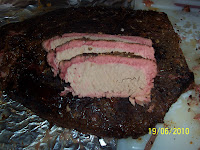The ribs: I prefer the St. Louis style ribs for a couple of reasons. While spare ribs are less expensive per pound, the St. Louis style are a great tasting meaty rib and it us much easier to get a lot of ribs into my smoker at one time. I use rib racks that will hold 5 full racks each. The most important thing to look for is to get only fresh ribs and not any that include the word "tender" on the package as most of these have been injected with a salt solution up to 12% by weight. You are paying for that liquid instead of all meat and it does leave them a little salty. I also try to inspect the ribs for a lower fat content on the meaty portion.
Once I am ready to prepare the ribs and have everything I need ready for them, I take them out of the cooler and get them ready for the smoker fairly quickly to keep the meat from room temperature any longer than they have to be. I usually like to do this the night before smoking as it gives the rub longer to get into the meat and it is a bit of work to do early in the morning. The next step is to remove the membrane from the bone side of the ribs. It isn't easy to get off but it produces a better tasting and eating rib. To do this, with a sharp pointed knife, carefully slice through just the membrane and not any deeper than that as seen here.
Using a paper towel, grab the membrane and pull it towards the side of the rack. After a little practice, this becomes much easier. Once this is finished, it is time for the adding of the dry rub. If doing this the night before and I have several racks to do, I stack them in a large roasting pan with wax paper in between the layers to keep the rub from coming off. It seems to work very well. Store the ribs in the cooler or fridge this way overnight.
The ribs are now ready for the smoker but the smoker needs to be ready for the ribs. I load up the charcoal in my Weber Smokey Mountain Cooker and use a charcoal chimney and the "Minion Method" of adding hot coals to the layer of charcoal. In this smoker, this will bring the temperature up to the needed temp and keep it there all day with little tinkering. I spray the rib racks with a non-stick spray to make it easier to get them back out of the racks. Let the temperature get well above smoking temperature because adding the ribs is going to cool it back down plenty. I also fill the water pan with water before heating the smoker. Once you add the ribs, add in the needed wood chunks for flavor. I use hickory on most of the meats I smoke but will also use oak and some apple for pork. Smoke the ribs at around 225 degrees for 3 hours keeping the smoke rolling in the smoker. Now to make some purists cringe, I then pull them out of the smoker, wrap them completely in heavy foil with 1/4 cup or so of apple juice and either put back in the smoker or a preheated oven and keep them in for 2 hours at 225 degrees on a sheet tray if in the oven. This stops the ribs from burning on the thinner edges and creates a near fall off the bone tenderness that everyone I know enjoys more than chewy ribs with burnt edges. I know if I get into competition BBQ, I will have to change that somewhat but I make ribs for people to eat and that is how they like them. They look like this at this point.
Now it is time for the sauce. I brush each rack with a nice layer of sauce and put them back in the rib racks. They go back in the smoker for an hour with plenty more smoke rolling through the smoker. They are finished after this and look like these.
If you are going to cut into these right away, use a very sharp knife in between the bones to prevent the rib meat from pulling from the bone. Or, do what I do and use an electric knife. It does a great job. And if you save some for later, brush them again with the sauce and put them in foil to reheat them in the oven at 300 degrees for 30-40 minutes. For saving any extra ribs for another time, wrap the ribs tightly in a couple layers of foil and add to a heavy duty freezer bag for freezing. This works very well and they taste like fresh smoked ribs after thawing and reheating. Enjoy!!!!!










